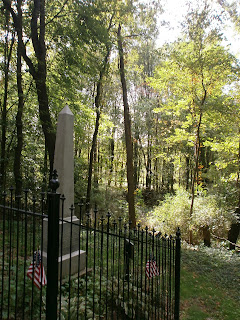William McKinley is an interesting president and human being, more so than most people realize. Although it was a brief conflict, he was a wartime president during the Spanish-American War. His presidency also ushered in a time of great prosperity in America, largely due to his insistence for high tariffs on foreign goods (which protected American industry and its workers; if foreign products are more expensive, people are inclined to buy American). He also cared for his wife Ida,who was frail and sickly, with great compassion and tenderness. However, I would like to take a more in depth look at his assassination and burial.
An anarchist named Leon Czolgosz waited for his opportunity to kill McKinley, to get close enough to him to have a good shot. The McKinley's were touring the U.S., and they were making a stop at the World's Fair in Buffalo, N.Y. The president planned to hold a meet and greet at the Temple of Music (a concert hall,which was demolished after the fair ended) on September 6th, 1901. The gun was concealed in a hankie, as Czolgosz joined the throng of people who wanted to meet the president, and the president was shot twice in the stomach. One of these bullets lodged itself deep in the president's abdomen, and although the president appeared to grow stronger in the coming days, he had gangrene deep inside his body. The president died on September 14th, 1901 (and it was his death that led to the Secret Service having a primary role in protecting the president).
President McKinley's body was to lie in state in Buffalo and Washington, before being taken home to Canton, Ohio for his funeral. A silent film of his funeral procession into West Lawn Cemetery can be seen here (it's pretty amazing, considering this happened over 110 years ago):
http://www.youtube.com/watch?v=Ec7YOy9wkwM
A large scale monument was planned for the final interment of the president. Until this monument was completed, the president's body was to rest in the receiving vault at West Lawn Cemetery:
The receiving vault seems archaic to us now, but it was necessary before machinery made grave digging possible in winter, when the ground freezes. Those who died during the winter would rest in this vault until their grave could be dug in the spring. In President McKinley's case, he would stay there until his monument was completed in 1907. Mrs. McKinley visited her husband almost everyday in the receiving vault, until her own death in May of 1907. The attachment that the Mr. and Mrs. McKinley had to each other was profound, and Mrs. McKinley never stopped mourning or fully recovered after his death.
McKinley Memorial was completed a couple of months after Mrs. McKinley's death, and the president, his wife, and 2 daughters were re-interred in the grand monument. Driving up to the monument takes your breath away; it's right in front of you as you pull in the driveway. The monument is really an amazing sight, and pictures can't do it justice:
The memorial and museum are open to the public, and more information can be found here, about visiting or history in general:
http://www.mckinleymuseum.org/
West Lawn Cemetery is practically next door, so I would also recommend visiting the cemetery. They are both gorgeous and full of history, so what's not to love?

















































